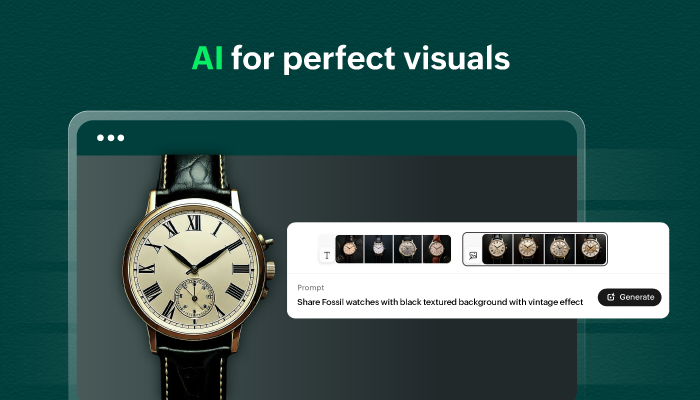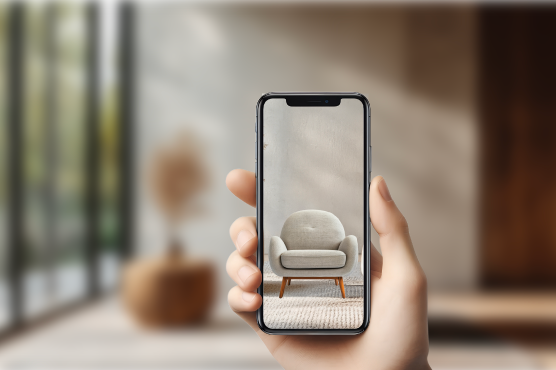- HOME
- Ecommerce trends
- The role of AI in ecommerce product photography
The role of AI in ecommerce product photography

How important is product photography in ecommerce?
Picture this: You land on a website with poorly lit, unappealing product photos. Would you trust that seller enough to buy from them? Probably not.
In ecommerce, first impressions aren't just important; they're everything.
Product photography is the lifeblood of ecommerce because:
It's your virtual handshake with the customer
Clear, high-quality images build trust in the authenticity of the product and the seller. This is especially crucial when you sell online as customers cannot physically interact with the product.It makes the uncertain certain
Visually appealing and informative product photos and product pages reduce customers' uncertainty during online shopping and increase conversions.It minimizes returns
The better a customer understands the product visually, the lower the chances of post-purchase returns and disappointment.
As the saying goes, "A picture is worth a thousand words." In ecommerce, it's also worth a thousand clicks. So, don't just sell a product—sell the experience.
Take IKEA, for example. When you walk into an IKEA store, you don't just find products arranged in aisles. You find them placed in complete, immersive room setups. This experience lets you imagine how the product would fit into your home or office, and how it aligns with your expectations and needs.
Apply the same principle to your ecommerce website and create visuals that help customers imagine your product as part of their lives.
But let's face it. Traditional product photography costs a lot of time and money, not to mention the uncertainty of achieving the desired output.
AI in ecommerce photography: The big picture
AI isn't just a writing assistant anymore. Its skillset is rapidly expanding, and it's now transforming ecommerce photography. You no longer have to hire photographers, rent studios, or invest in expensive equipment and post-production editing. With AI tools producing high-quality product photos infinitely faster and more affordable than ever, AI product photography is empowering businesses to operate more efficiently and make their product pages look like a million bucks without spending as much.
Here are some ways AI can help you produce amazing product photos that align with your branding.
Product photo enhancements from blah to beautiful
AI tools for product photography like Adobe Firefly can retouch images by automatically adjusting brightness, sharpness, and contrast, and removing blemishes to make them picture-perfect.
AI can remove specific objects from your product photos and reposition or rotate products within their backgrounds for a polished, professional look.
Resizing and optimizing product photos for different uses like product pages, social media posts, website banners, and ads without compromising on the picture quality is a breeze with AI apps like Claid AI.
Bid adieu to boring backgrounds
Clean and simple: Tools like Photoroom can remove backgrounds from the images, leaving a plain or colored background with clear focus on the product. Busy backgrounds can also be blurred or replaced with stock backdrops that best fit your products.
Custom backgrounds: AI tools like Pebblely enable you to create your own high-quality aesthetic backdrops by simply typing in a prompt or providing reference images for inspiration.

Lifestyle imagery: Generate lifestyle images for backgrounds to showcase your products in real-world scenarios using AI tools like Flair AI. Here's where you can apply the IKEA example to sell more.

Bring products to life with virtual tech
AI doesn’t stop at flat images. It introduces interactive and immersive experiences.
3D models: AI creates 3D models of products that customers can rotate and view from all angles. By implementing 3D models for its electric toothbrushes, oral hygiene brand Oral B increased their add-to-cart rate by 18%.
Augmented Reality (AR): Using AI technology, you can help customers envision your products in their environment before making a purchase. IKEA launched the IKEA Place app that uses AR to help shoppers visualize furniture in their own room and saw a 43% increase in their online sales.
Virtual try-ons: AI tools like Vue.ai let customers see how products like clothing, accessories, eye wear, or makeup will look on them, enhancing their shopping experience. Studies show that virtual try-on technology can grow sales by up to 30% and minimize returns by 20%.
What to watch out for when using AI in product photography
AI can do wonders, but there are some things to keep in mind.
Keep it real: For ecommerce businesses, it is important to give customers the best possible visual experience of products. However, going overboard with AI-generated enhancements can result in your products looking unrealistic and deceptive, ultimately wearing down customers' trust. Balance AI imagery with authenticity to show products as they truly are.
Choose the right tool: Some AI tools come with a learning curve, so look for user-friendly options like Pixelcut for product photography if you aren't too tech savvy.
ROI over hype: AI should save you time and money, not add unnecessary expenses. Analyze whether the tool’s cost justifies the benefits, especially if you're a small or niche brand.
Wrapping up
Product photography plays a vital part in influencing purchasing decisions. It has the potential to increase online sales, reduce product returns, and accelerate your marketing campaigns. As AI technology continues to evolve, its role in ecommerce photography will only expand, unleashing even greater potential for online retailers worldwide.

